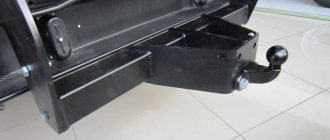Hard work on a personal plot is considered the norm. Modern summer residents follow the example of the older generation, continuing to bend their backs while growing vegetables and fruits. If you value your work and are tired of manually dragging sand, fertilizers using stretchers and buckets, a garden wheelbarrow with a motor is what you need.
The situation is no better at construction sites of country houses. A construction wheelbarrow with a motor will make the work easier here. It seems that the different models are practically indistinguishable from each other, but some selection criteria still exist. A small rating in different price categories will help you choose which model is worth buying.
DIY garden wheelbarrow, photo
Many people are interested in the question: why do homemade workers make construction wheelbarrows if they are sold on any construction market and in construction hypermarkets? People are driven by two reasons:
- The flimsiness of factory-made garden and construction wheelbarrows.
- Poor design, which leads to increased stress on the arms and back.
MussechkaForumHouse participant
We bought a car at the store. She couldn't even stand digging a well. They carried earth on it. The metal of the frame was deformed. The wheel fell off. We need to buy a new one. In my opinion: homemade ones are stronger and last longer.
viktor50FORUMHOUSE user
About ten years ago I bought a well-made construction wheelbarrow. Its wheels are located approximately in the middle of the body. Most of the cars that are sold now are poorly designed. Their wheel is located closer to the front of the trough. When lifting a loaded wheelbarrow, half the weight falls on the user. And if the front body has a bevel at an angle, then even more.
Therefore, many people prefer to roll up their sleeves and make a garden wheelbarrow “to last forever.”
cgtwFORUMHOUSE User
I had a purchased car. She did not survive serious construction. I decided to make my own. The drawings were made at a military factory. The design is balanced. Low center of gravity, and the main weight of the load goes to the wheel. Therefore, you get much less tired when working. The metal used was second-hand. I took the wheel from a helicopter. It took only 400 rubles to make a construction wheelbarrow. I carry 50-60 kg on it. Nothing breaks. Driving it is a pleasure.
Types, features, advantages and disadvantages
This type of equipment is distinguished by its maneuverability. It can have one, two, three and four wheel designs. The first two types of structures are the lightest. Such models cannot transport cargo weighing more than 150 kg.
Self-propelled wheelbarrows produced by manufacturers are divided into 4 large groups:
- Universal . They are structures with removable side panels. Mostly, trolleys of this type are used for transporting dry bulk materials.
- With platform . There are no sides in the design. Carts are used to move large items.
- Dump trucks . Self-propelled wheelbarrows of this type are equipped with a load dumping function. Such structures are convenient for transporting soil, bags, firewood, etc.
- Folding . Folding models with walls made of thick fabric. They have a low load capacity and are designed for transporting small loads. Convenient to store in small areas.
Self-propelled wheelbarrows are classified according to the type of engine:
- diesel;
- gasoline;
- electric.
Each type of design has its own advantages and disadvantages. Diesel self-propelled cars are considered the most powerful. Their main disadvantage is their high cost. It is larger than gasoline and electric models. The latter are considered the most convenient option for home use. They are powered by rechargeable batteries.
Gasoline models are often preferred by landscape designers and builders. Self-propelled wheelbarrows on a caterpillar base are designed for working on swampy ground and driving through mud. They have narrowly targeted applications. Such wheelbarrows have a heavy, massive structure. In the garden, it is most convenient to drive one-wheeled wheelbarrows. They can be rolled between beds without fear of breaking the plants.
The design of one-wheeled wheelbarrows is also convenient for unloading. You just need to lift its handles and tilt it to the right or left. The disadvantage of one-wheeled wheelbarrows is poor stability when loading. It is necessary to constantly ensure that it does not tip over due to improper distribution of the cargo mass on the sides. The wheels may catch on the stationary stops of the structure while driving in a loaded state on uneven ground.
Materials you will need:
- two wheels from a passenger car and one from agricultural machinery;
- engine from a walk-behind tractor (a 6.5 hp gasoline engine is used here);
- rear axle from a passenger car;
- profile pipe;
- sprockets and chains from motorcycles;
- steering wheel;
- tension rollers and timing belts;
- nuts, bolts and springs;
- sheet metal;
Here is a self-propelled cart shown in the photo.
The following shows the process of making the cart.
We take the rear axle from the car and shorten it, cut off the stockings and shorten the axle shafts.
The frame for the trolley can be welded from a profile pipe or channel.
We attach a large sprocket to the axle shaft of the differential drive gear. We will install the engine on the frame cross members and a corner welded to the left in the direction of travel outside the spar opposite the cross members.
We install a small pulley on the motor shaft, and put a belt drive on a large pulley with the required gear ratio. We attach the large pulley to the shaft on two bearings in a housing (a piece of pipe) welded to the stand. On the other side of the shaft we place a small sprocket, which we connect with a chain to the large sprocket on the axle shaft of the differential drive gear to ensure the desired gear ratio.
This design allows you to reduce engine speed and increase traction.
To install the steered wheel, we will make a narrow frame from a profile pipe and attach it to the side members of the main frame using two inclined posts and two jibs welded to the near cross member.
At the end of the narrow frame, from the inside we attach a wheel rotation unit, consisting of an axle, bearings, a housing and a paired sprocket. We weld a cross member with a stand to the lower end of the axle, at the bottom of which we attach the wheel axle. On the other side of the narrow frame, we mount a roller from below and connect it to the sprocket on the wheel axle with a chain. On top of the frame in the center we weld a steering wheel shaft rotation unit, at the lower end of which we attach a paired sprocket that presses the chain from the outside.
Now let's make a belt clutch. Under the lower branch of the belt, located closer to the wheelbarrow, we attach the tension roller to a bracket, which we weld to the axle and secure with two supports to the narrow frame. On the other side of the axle we attach the pedal, placing it on the left in the direction of travel. If you press it, the roller, rising, presses the belt against the pulleys and engages direct transmission.
Under the lower branch of the belt, located closer to the wheelbarrow, we attach the tension roller to a bracket, which we weld to the axle and secure with two supports to the narrow frame. On the other side of the axle we attach the pedal, placing it on the left in the direction of travel. If you press it, the roller, rising, presses the belt against the pulleys and engages direct transmission.
Between the wheels we create a support for a rotating frame from a profile pipe, which can tilt forward. We attach to it a container made of sheet metal and thin profile pipes with three vertical and one inclined side at the front.
Well, the self-propelled wheelbarrow is ready to go! The trolley is very convenient and easy to operate, watch the video:
Homemade author: Ildar Sunnagatulin.
Factory solutions
What are the differences between cart wheels? Why do their prices vary widely? There are quite a lot of differences between them.
Fastening
A wheel with a bracket is useful because when the wheelbarrow is tilted, it independently turns in the desired direction. This feature will make the 1-wheel garden cart more manageable. But a 2-wheeled garden cart will do just fine without this element: any rotation of the wheel will not cause its center of gravity to shift beyond the wheelbase.
When the wheelbarrow is tilted, the bracket itself turns in the desired direction.
Swivel wheels are useful if you have to roll the wheelbarrow on paths with a small turning radius. For movements in a straight line, products with a fixed position of the axis of rotation are sufficient.
However: a 4-wheeled garden cart with swivel wheels is much more convenient, since it can move in any direction, and not just along its longitudinal axis. Of course, this property is only useful on smooth, hard paths.
Which option to choose
It is best to use a device with an industrial motor as an auxiliary transport. For example, a self-propelled trolley TS 350, photo. Unlike low-power Chinese self-propelled vehicles, the “Lunokhod”, as its owners affectionately call the car for its appearance, has a whole bunch of advantages:
- High load capacity, 450-500 kg of bulk cargo fits into the body;
- Six-wheel suspension design, providing high cross-country ability and maneuverability;
- Powerful UMZ-5B engine of 5 hp. and relatively low fuel consumption - 1.5-2.1 l/h.
The car has established itself as an indispensable self-propelled vehicle. Six wheels with all-wheel drive provide excellent stability even on extreme off-road conditions. The alignment of the trolley is done quite competently; the suspension design ensures uniform adhesion of all wheels to the ground. The design of the TC350 supporting frame allows the use of a plow or snow shovel. In general, most modern Chinese and European walk-behind tractors look rather pale against the background of the Lunokhod.
Among the shortcomings of the TC350, experts note the imperfection of the chain transmission and the lack of a cabin on the self-propelled trolley. But considering that this is a home transport, the presence of a roof is not so important. Problems with transmission can be solved by installing a more powerful double-row chain with a link pitch of 19.5, but with the purchase of a trolley, things are much worse. Most fans of this type of technology do not have the opportunity to buy a new self-propelled cart with an engine.
For your information! Production of the Lunokhod TS350 by the Tyumen Engine Plant has been discontinued.
On the secondary market, you can buy a similar self-propelled cart for 1.5-2 thousand dollars, with a badly worn engine. It is clear that any equipment, and especially a cart, can be repaired and restored, but it is often cheaper not to deal with repairs, but to make a self-propelled cart with your own hands.
How to choose correctly
What self-propelled car would you buy for yourself?
Diesel/PetrolElectric
When purchasing any product, the buyer primarily focuses on his financial capabilities. You can find a decent model in any price category.
When buying a car, you need to pay attention to:
- engine power;
- load capacity;
- trough volume;
- number of wheels;
- presence of a tilting mechanism.
Expert opinion
Levin Dmitry Konstantinovich
An important selection criterion is the dimensions of the products. The convenience of storing equipment, transporting and moving between beds depends on them. It should be taken into account that one- and two-wheeled structures have maximum maneuverability, but have a minimum load capacity. For four-wheeled self-propelled wheelbarrows, it is important to have a tipping function. This technique has maximum load capacity.
An important technical characteristic of the equipment is the diameter of the wheels. Wheelbarrows with wheels with a diameter of 30 cm or more have good maneuverability on corrugated surfaces.
It is better to purchase self-propelled wheelbarrows with a frame and trough made of steel. Such models have increased strength and are not subject to deformation. The disadvantage of steel structures is their heavy weight and tendency to corrosion when the surface layer of product elements is damaged.
Wheelbarrow engines must be protected from dust, dirt and water. The purchased equipment must have a manufacturer's warranty.
Main stages of work
At the next stage, we cut off a small piece of the construction angle and drill mounting holes in it. Then we attach it to the gear motor housing.
After this, we install the previously removed wheel back onto the cart, having first put the chain on the sprocket. We mark and drill holes in the trough for mounting the gear motor.
The author uses a battery from a screwdriver as a power source for the electric motor. We connect the battery to the gear motor and place it in a bag, which we attach to one of the trolley handles.
You can watch the video on our website for details on how to make an electric drive for a garden cart with your own hands from a windshield wiper gear motor.
Rate this post
[Votes: 4 Average rating: 5]
Why do tires and tubes fail quickly?
The main reason for failure is the presence of a small amount of natural rubber in the composition. Phenols are often used instead. With prolonged use or elevated temperatures, an unpleasant odor appears. At lower temperatures, the elasticity of the wheels is lost.
The choice of a garden wheelbarrow must be approached carefully, and special attention should be paid to the wheel, since it is this wheel that most often fails after 1-2 years. https://www.youtube.com/embed/IqRJN7ajmJA
In this article, the “How It’s Done” website will tell you how to repair the wheel of a garden wheelbarrow yourself.
If you have a different model of car, it’s okay, because their wheels differ only in size.
If the wheel of a garden wheelbarrow gets punctured, it is not necessary to change it entirely. You can simply replace the camera.
First, determine the wheel size using the markings on the tire and buy a new tube of the appropriate size.
Then remove the wheel from the wheelbarrow frame.
Unscrew all the wheel bolts and remove the old tube from the tire.
Make sure once again that the markings on the new tube match the markings on the wheelbarrow.
Then place the new tube into the tire and reassemble the wheel in reverse order.
The wheel with the new tube is assembled and can be installed back on the frame.
After that, use a pump to pump it up to the desired pressure.
Replacing the garden wheelbarrow wheel tube is complete.
To see clearly how to replace the camera in a garden wheelbarrow, we recommend watching the video:
Basic information
Before carrying out work on the manufacture of a trailer, it is necessary to develop a detailed action plan and adhere to it.
The work plan for the manufacture of a trailer for a walk-behind tractor looks like this:
- At the preparatory stage, it is necessary to familiarize yourself with the structure of the mechanism and analyze its functionality depending on the power of the walk-behind tractor.
- Make a design sketch. A trailer diagram drawn up yourself will greatly simplify the work.
- Calculate the dimensions of the cart for the walk-behind tractor.
- Design a drawing of the trolley, which includes the main components, parameters and dimensions of the parts.
- Plan the operating principle of the main and additional mechanisms, think through ways to connect all the components and parts, and their functioning.
- Prepare a list of necessary materials and tools.
- Start the assembly and finishing process.
Depending on the ability to transport cargo, trailers are divided into 3 types:
- A simple 1-axle attachment for walk-behind tractors with a lifting capacity of up to 70 kg. Its design is simple and inexpensive.
- Universal cart with a carrying capacity of up to 110-120 kg. Often used in households.
- Carts for walk-behind tractors with a carrying capacity of over 120 kg. Such mechanisms are designed to move heavy loads, so they have a more complex design, which increases the cost of materials for the frame and cladding. The functionality of this technology is expanding.
Based on these parameters, a material is selected based on strength for the frame and finishing of the mechanism.
Design
The main structural elements are: trough, frame, wheels, engine. The most common trough material is metal. The lightest models have aluminum troughs. This material is lightweight, but prone to deformation. It is better to use models with an aluminum trough for transporting bulk materials. To transport heavy loads, you need to purchase wheelbarrows with a trough made of steel.
The thicker the walls of the trough, the stronger the structure.
The shape of the trough is round and rectangular. Standard trough volume is from 50 to 120 l. The trough is attached to a frame, which is made from a profile with a circular cross-section. Lightweight wheelbarrows have a monolithic frame design. Wheels are attached to the frame. They can be mounted on bushings or bearings. Wheel tires can be inflatable or cast.
Drawings of a homemade construction wheelbarrow
Those who are interested in homemade products will find the drawings of a two-wheeled car made by VicktorVR useful.
To make it you will need:
- Profile pipe with a cross-section of 25x25x2 mm, length 6 m.
- Profile pipe with a cross-section of 15x15x1.5 mm, length 6 m.
- Galvanized metal sheet.
- Two threaded rods M10 or M12.
- M10 or M12 nuts and washers.
- Self-tapping screws for metal.
- Two wheels.
Final version.
Drawings of a garden wheelbarrow.
The length of the handles is 1.5, not 1.3 m, for a height of 1.8 m.
VicktorVRUser FORUMHOUSE
Wheels for a construction wheelbarrow cost me 1,100 rubles. The wheelbarrow weighs no more than 20 kg. Load capacity – 100 kg. It can withstand all 200 kg, but the wheels are rather weak, you need to look for a more reliable option. All that remains is to make the steps.
For ease of use, bend the handles of the wheelbarrow.
We build a self-propelled motorized cart with our own hands
According to most home-made craftsmen, the main interest in building such devices is to make a home-made self-propelled cart with minimal costs for purchasing spare parts. Moreover, there is no need to register or draw up documents for homemade transport. Even if you have to go out onto the road, there will be no complaints from drivers or the traffic police, provided that the self-propelled cart does not interfere with road users and moves at a speed of no more than 7 km/h.
Wooden wheels for a garden wheelbarrow
Practice shows that wheels are traditionally the weakest link of any construction vehicle. They cannot withstand heavy loads. Tires puncture, crack, slip off the wheel rim, etc. A radical solution to the problem is proposed by a portal member with the nickname MrGinaki. He made “indestructible” wooden wheels for the wheelbarrow.
The width of the car body is 650 mm. Length – 900 mm.
How to make homemade wheels for a wheelbarrow is clearly shown in the photo instructions.
The finished wheel has a diameter of 35 cm.
MrGinaki
I carried 6 bags of cement, 50 kg each, in a wheelbarrow. I also use it as a bucket for mixing cement.











